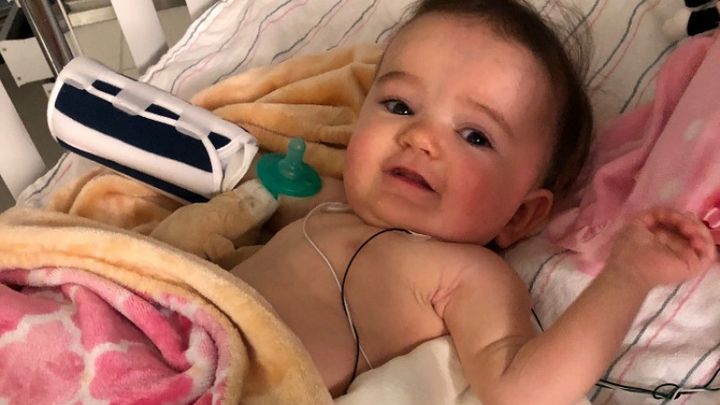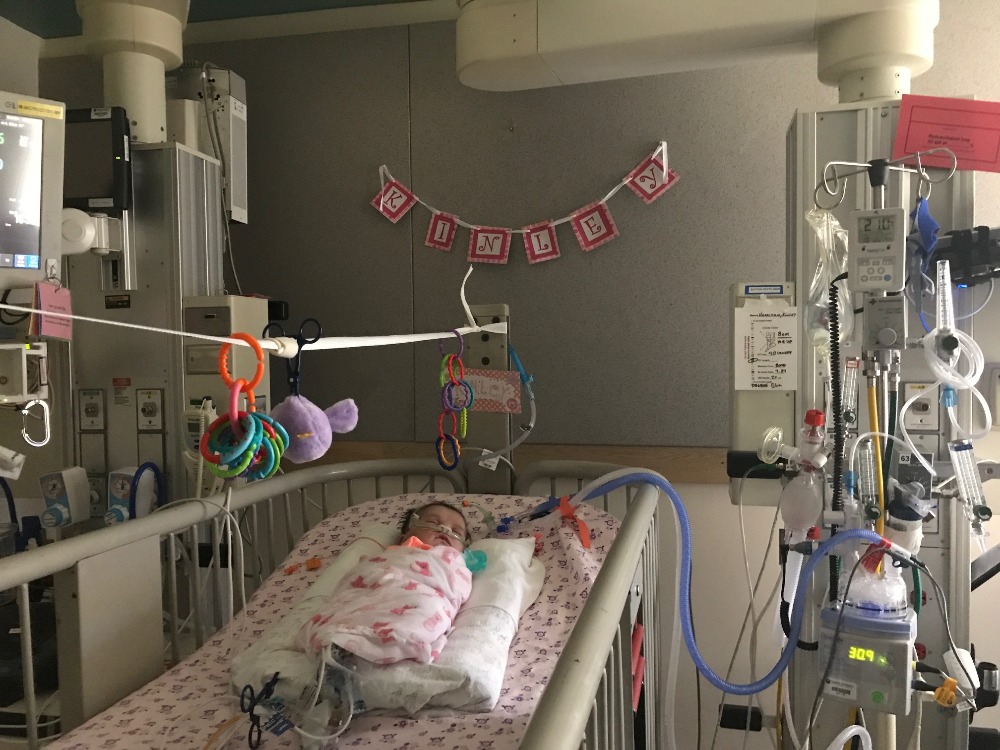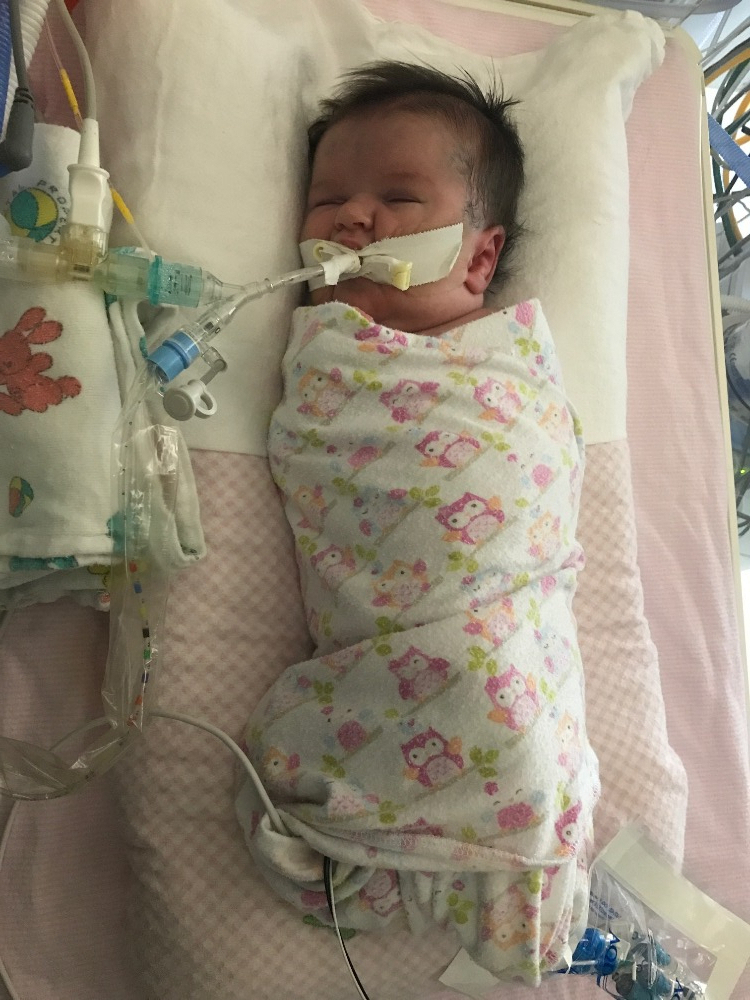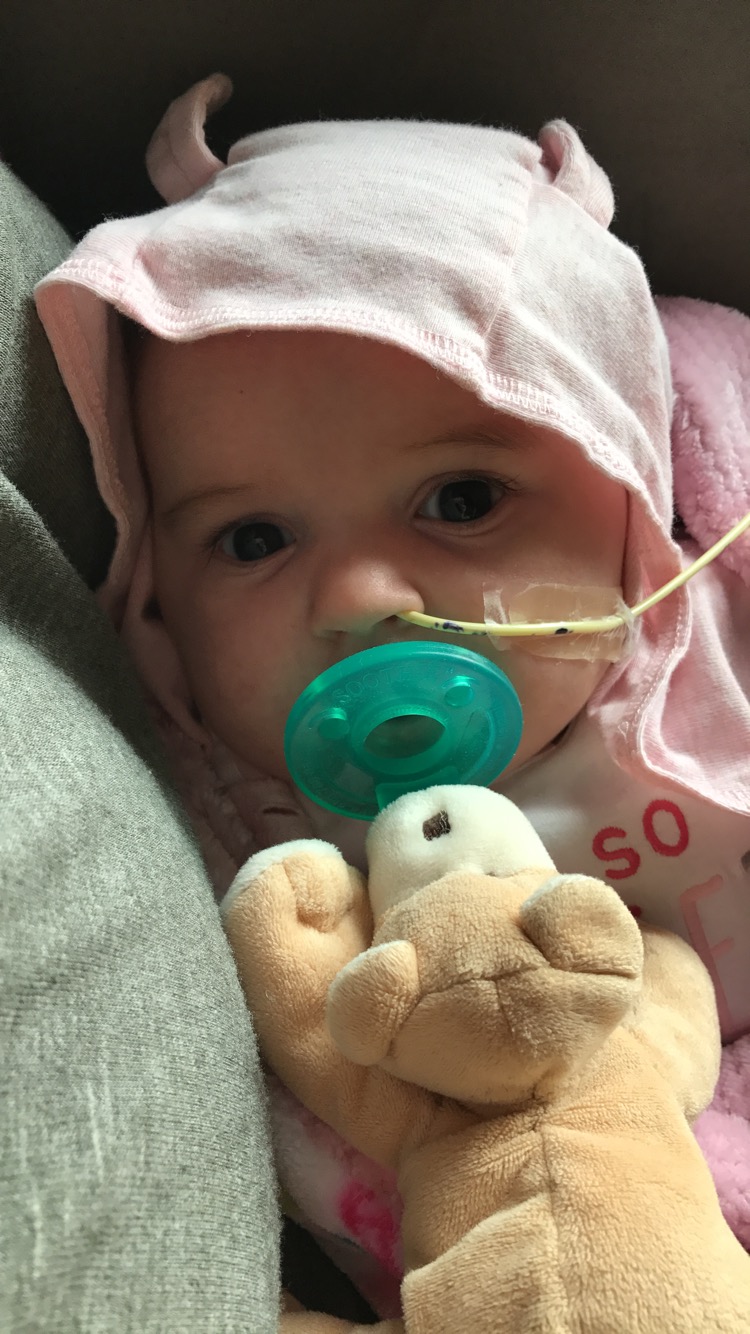
Kinley's VOGM Journey
Donation protected
 Meet Kinley, she was born July 11th, 2017. Being a young, single first-time mother, I was overwhelmed with love and joy when my daughter was born. Nothing could prepare me for the emotions I experienced when Kinley was diagnosed with an extremely rare, life threatening brain aneurysm malformation just ten days later. By just looking at her you would have no idea that she is anything less than a perfectly healthy baby girl. Yet, the malformation she has affects the veins deep within the tissues of her brain. Kinley’s condition is called Vein of Galen Malformation (VOGM). VOGM is so rare that it’s true percentage of how many people are diagnosed with it is still unknown. Many medical professionals believe it affects less than 0.01% of the Earth’s population. That is less than a one in a million chance of being born with this condition, with only a few hundred people being diagnosed with VOGM in the United States each year. This condition is still very unfamiliar to many doctors and only a handful of neurologist/neurosurgeons in the world are equipped to treat patients with it. The treatment for this condition is still relatively new. And while the technology and medicine used to treat VOGM have advanced in the past 20 years, there is still a huge part of this experimental procedure that is uncertain. For the most part, the outcome and projection of a VOGM patient’s life-span and quality of life is a grey area. The oldest living person with this condition is only in their early 20s, so the long-term outlook is a mystery. Kinley’s life will be taken one step at a time, one procedure at a time and one day at a time.
Meet Kinley, she was born July 11th, 2017. Being a young, single first-time mother, I was overwhelmed with love and joy when my daughter was born. Nothing could prepare me for the emotions I experienced when Kinley was diagnosed with an extremely rare, life threatening brain aneurysm malformation just ten days later. By just looking at her you would have no idea that she is anything less than a perfectly healthy baby girl. Yet, the malformation she has affects the veins deep within the tissues of her brain. Kinley’s condition is called Vein of Galen Malformation (VOGM). VOGM is so rare that it’s true percentage of how many people are diagnosed with it is still unknown. Many medical professionals believe it affects less than 0.01% of the Earth’s population. That is less than a one in a million chance of being born with this condition, with only a few hundred people being diagnosed with VOGM in the United States each year. This condition is still very unfamiliar to many doctors and only a handful of neurologist/neurosurgeons in the world are equipped to treat patients with it. The treatment for this condition is still relatively new. And while the technology and medicine used to treat VOGM have advanced in the past 20 years, there is still a huge part of this experimental procedure that is uncertain. For the most part, the outcome and projection of a VOGM patient’s life-span and quality of life is a grey area. The oldest living person with this condition is only in their early 20s, so the long-term outlook is a mystery. Kinley’s life will be taken one step at a time, one procedure at a time and one day at a time.I am setting up this funding page because I have been asked by my loving friends and family how, in anyway, they could help support Kinley. After much consideration, I have decided due to the amount of medical treatment Kinley will need, along with travel expenses, this is the best way everyone can help. Your financial support, along with a lot of prayers, will allow myself to remain pursuing the most advanced medical treatments possible for Kinley. It will also help meet the financial obligations it takes to get Kinley back and forth from Seattle to Boston for the necessary life-saving embolization procedure which is performed by Dr. Darren Orbach at Boston Children’s Hospital. Currently Kinley has at least two more times that she will need to travel to Boston. The logistical and financial challenges are beyond anything I could have imagined. Given the uncertainty of the future, I do not know what the total costs for her medical and travel expenses will end up being at this time. This is a lifelong condition that will continue to require all I have mentally, physically and financially to support Kinley. Every dollar raised will go towards the care of this amazing little girl. I can only hope that your generosity will help diminish the financial burden of this journey, so that I can remain focused on Kinley as my top priority.
I will provide updates as they come through her Facebook page, “Kinley’s VOGM Journey” here.

 What is VOGM precisely? In VOGM misshaped arteries in the brain connect directly with veins instead of connecting with the capillaries that normally help slow blood flow. Such malformation forms around 6-10 weeks of gestation and can sometimes be detected in utero on ultrasound. In Kinley’s case, it was not. VOGM causes problems such as:
What is VOGM precisely? In VOGM misshaped arteries in the brain connect directly with veins instead of connecting with the capillaries that normally help slow blood flow. Such malformation forms around 6-10 weeks of gestation and can sometimes be detected in utero on ultrasound. In Kinley’s case, it was not. VOGM causes problems such as:- The heart to work overtime to get blood to the rest of the body. This will lead to congestive heart failure. The heart failure is due to the demand of blood needed to supply the malformation that can steal 80% or more of the hearts total output of blood. Cardiac failure is also the most common cause of death in such patients.
- Blood pressure in the arteries from the heart to the lungs may rise, causing a serious condition called pulmonary hypertension. This would require additional medical management and monitoring.
- The high pressure of blood in the veins can lead to widespread brain injury and sometimes causes severe loss of tissue in the brain.
Please click here see the video of Dr. Darren Orbach from Boston Children’s Hospital explain with visuals of this condition.
 Background of Kinley’s story:
Background of Kinley’s story:After just ten days of being home Kinley started having difficulty breathing along with cold sweats. Concerned, I took her to the local ER. Upon arrival, Kinley was given oxygen and stabilized to begin tests to determine what was causing her so much distress. Doctors had an ultrasound done of her chest where they found Kinley’s right ventricle of her heart to be greatly enlarged. She was then transferred to Mary Bridge Children’s Hospital in Tacoma, Washington for specialized care in pediatrics with high-output cardiac failure.
At Mary Bridge, doctors continued to do tests to narrow down possible reasons for her complicated breathing and enlarged heart. Doctors and nurses compiled a laundry list of things that could be causing such symptoms. During routine care, a nurse noticed Kinley’s fontanel pulsating which pushed doctors to order an ultrasound of her head. The results were both heartbreaking and life-changing. It showed Kinley had Vein of Galen Malformation (VOGM) along with slight brain damage to the right side of her brain.
After the initial diagnosis, Kinley was transferred to Seattle Children’s to be consulted and monitored by some of the best doctors, nurses and specialists in Washington State. The goal of treating VOGM is to eliminate or decrease as much of the blood flow through the malformation as possible. The most common treatment is endovascular embolization – a minimally invasive surgical procedure where tiny coils or “glue” are placed in the affected vein to promote clotting. This procedure may have to be done multiple times throughout Kinley’s life to adhere to the constant changes in the brain as she develops and grows. Doctors were able to stabilize Kinley’s symptoms enough that she was able to come off the ventilator and eventually was on room air. She then became independent enough to go home, which was the best environment for her to continue to grow and develop in the most productive environment. Due to the prolonged timeline for the embolization procedure, I chose not to return to work full-time so that I could tend to the 24-hour at home-care Kinley required. She must be monitored for seizures, strokes, signs of heart failure, and/or neurological changes at all times, she may look like any other baby but she is most certainly not.
Fast forward to September 2017, Kinley has made leaps and bounds from when she was first admitted to the hospital. But this journey is far from over. Kinley had to wait until she was 6 months old before they could do the first embolization procedure. Knowing that VOGM is such a rare condition, that’s only treatment plan was an extremely risky procedure, I searched for second opinions to be sure that Kinley was getting the absolute best care. After a lot of research I found Dr. Darren Orbach at Boston Children’s Hospital. After contacting his team, I had the chance to speak with him personally over the phone. Dr. Orbach explained in great detail how the procedure was done and the risks that it involved. He told me that this is one of the hardest Interventional Radiology procedures that could be done on an infant, but he was certain that he was the one for the job.
 In January prior to her procedure, Kinley had her first seizure. Seizures with this condition are not uncommon but added more precautions and medication to her daily routine. On January 22nd Kinley, myself and additional family members flew to Boston where she had her first successful procedure performed by Dr. Orbach. After the initial procedure, Dr. Orbach informed me that she would need a minimum of two additional surgeries, 4-8 weeks apart, to try and completely close off the malformation. For now, Kinley is back home waiting to get the next procedure scheduled. She continues to be the strongest and most resilient little girl our entire family has ever known.
In January prior to her procedure, Kinley had her first seizure. Seizures with this condition are not uncommon but added more precautions and medication to her daily routine. On January 22nd Kinley, myself and additional family members flew to Boston where she had her first successful procedure performed by Dr. Orbach. After the initial procedure, Dr. Orbach informed me that she would need a minimum of two additional surgeries, 4-8 weeks apart, to try and completely close off the malformation. For now, Kinley is back home waiting to get the next procedure scheduled. She continues to be the strongest and most resilient little girl our entire family has ever known.Kinley does have her share of difficulties. The brain damage found when Kinley was first admitted to the hospital has caused her to have some left side weakness. She receives weekly physical therapy in hopes to correct and strengthen her left side. She gets additional occupational therapy to help with her motor skills in eating as well, as the many months that she spent on feeding tubes have caused her to have a delay in her ability to eat solid foods. Though she has had many setbacks, Kinley continues to be the happiest and most easy-going baby there is. She is loved by every single person she is around.
Thank you for the outpour of love and prayers we have received so far. Please continue to keep Kinley in your thoughts and prayers.
 If you would like to read the updates I made from when Kinley was first hositalized, go to her CaringBridge page "Kinley Harriman" or click here.
If you would like to read the updates I made from when Kinley was first hositalized, go to her CaringBridge page "Kinley Harriman" or click here.Organiser
Kayla Harriman
Organiser
Puyallup, WA


